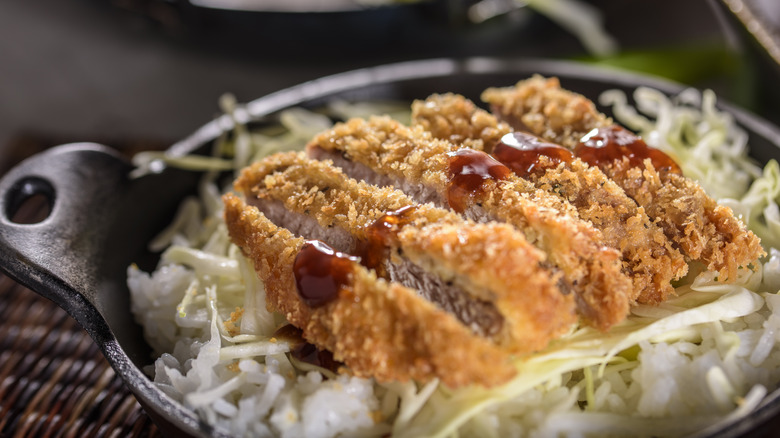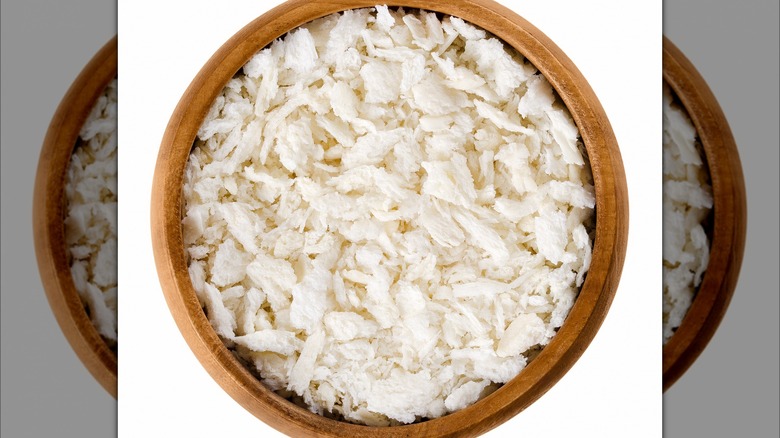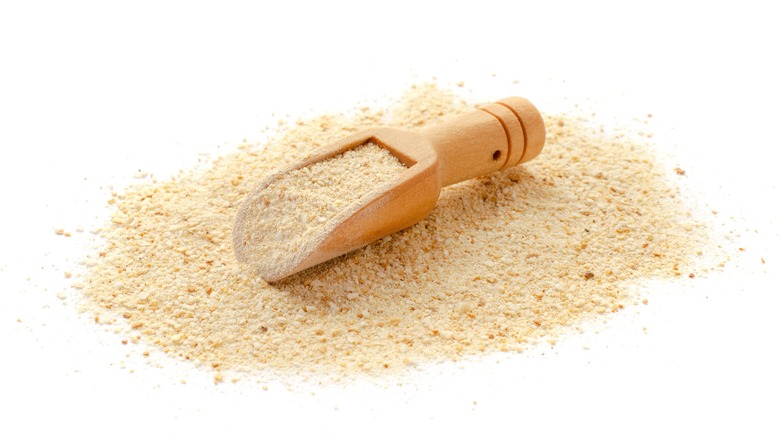The Difference Between Panko And Plain Breadcrumbs
Not all breadcrumbs are created the same, which is something you already know if you've ever dabbled something in panko, the Japanese variety of the ingredient that means the same in that language. Panko breadcrumbs are drier and more aerated than their normal counterparts, so they typically soak up less oil when you're cooking with them. This results in a final product with a delightfully crunchy crust, whether you're using them to bread a cutlet or just as a tasty topping on a dish like mac and cheese. Panko crumbs have typically been used in Japanese dishes like chicken katsu (a chicken cutlet, more or less), but as a neutral ingredient, it's quite easy to adapt them for uses beyond Japanese cuisine.
In comparison, regular breadcrumbs (particularly the store-bought variety) tend to be much more finely ground. They're used for similar purposes to panko crumbs, but smaller morsels mean there's more surface area, so they tend to absorb more moisture. This can be a benefit if you're using them as a binding agent for recipes like meatloaf or meatballs, although there is a little more potential for them to get soggy. They can also bring more flavor to the dish; while panko is made with very plain, white bread, regular crumbs can be made with any type of bread, from whole wheat to rye or pumpernickel, adding a tasty, bready note to a dish, if you so wish.
The lowdown on panko
What makes panko so different from the standard variety is that it's made using crust-free white bread that's been baked using an electrical current. The result is a light, airy loaf that's dried and ground down to the breadcrumbs you buy in the supermarket. Because the base bread is so light and aerated, it tends to crisp up easily when it's cooked in its breadcrumb form.
Panko is only made with white bread, so it's a pretty neutral breadcrumb, hence why it's so easy to adapt to any cuisine beyond its Japanese origins. But be warned — while it may add some crunch to your recipes, it doesn't contribute a whole lot of flavor. In Japanese cuisine, it's typically used for cutlets and deep-fried foods, as well as tempura-style coatings for deep-frying. Therefore, panko tends to work well for similar dishes in other cultures. Panko also works great as a crunchy topping that adds some extra texture to dishes like casseroles and pasta bakes — basically, anywhere where breadcrumbs might crop up. It should be available in most grocery stores, possibly in the international section or otherwise, alongside other breadcrumb products.
And what about regular breadcrumbs?
Standard breadcrumbs aren't all the same; they can be made with different types of bread (white, wheat, rye, and so on). Plus, they're more likely to have extra flavors or seasonings added, although it should be easy to find plain versions of them in the grocery store. So when it comes to flavor, they typically have an edge (although there's nothing stopping you from adding seasoning to plain panko). These regular breadcrumbs are easier to make at home since they don't require specially made bread, as panko does; all you have to do is dry out some bread and blitz it in a food processor.
Since regular breadcrumbs are more finely ground, they can work better in dishes where something needs to be fully encased in them — eggplant parmesan is one example. Similarly, dishes like schnitzel or fried cutlets require a bit more of a seal around the meat to lock in moisture, so finer crumbs are ideal here, as compared to looser panko crumbs. While they tend to be a bit less crunchy than panko, regular breadcrumbs should generally crisp up nicely if cooked right. For most other applications, the two can easily be swapped out for one another; choosing between the two really just depends on how much of that crunch factor you want in your dish.


